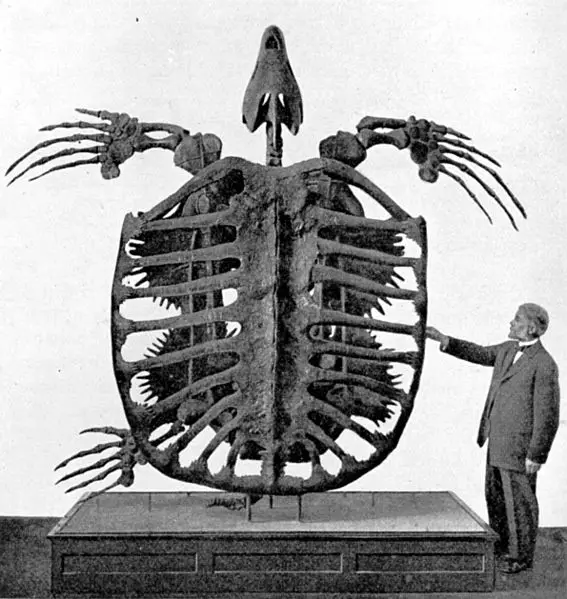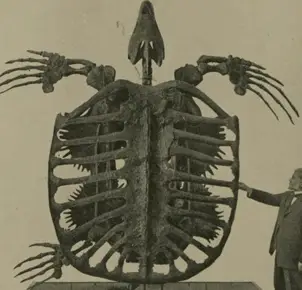Archelon – World’s Largest Sea Turtle
Table of Contents
Archelon, the giant turtle, was a well-known reptile name. It was discovered floating in the ocean after exercising its free will during the Cretaceous period 75 million years ago. It moved slowly and was seen drifting along the seashore in search of food. The turtle, which was classified as a reptile, measured 4.6 meters in length. Its beak was so powerful that it could easily break the shell of any organism, no matter how strong it was. The turtle had a lifespan of more than a century.
Archelon, like all turtles, had a solid-roofed skull with no openings (except for eyes, and nostrils).

Archelon was a massive marine turtle (Testudines) as big as a car. It lived in North America 74 million years ago (from the Upper Cretaceous) in the Western Interior Seaway, an epeiric inland sea. Fossils have been discovered in the American states of Kansas and South Dakota.
D. Wieland discovered the first remains of a giant sea turtle Archelon in 1895 near South Dakota. The Leatherback turtle is thought to be the closest relative of this giant turtle that is carrying the flag of ancient dexterous courage. The majority of the ancient giant turtle’s remains were discovered near South Dakota. It had many similarities to the ancient giant turtle Protostega Gigas, but it is assumed after extensive research that the Archelon was much larger in size.
- Archelon (Ruling Turtle) is his name.
- Are-kell-on (phonetic spelling).
- G.R. Wieland named it in 1895.
- Chordata, Reptilia, Sauropsida, Testudines, Cryptodira, and Protostegidae are the classifications.
- A. ischyros is the type species.
- Diet: Most likely soft-bodied organisms such as jellyfish and cephalopods.
- Size: 4 meters long by 4.9 meters wide.
- USA, South Dakota, and Wyoming are known locations.
- Time period: Cretaceous, late Campanian to early Maastrichtian.
- There are few fossil specimens.
The Archelon’s physical characteristics inspire awe and wonder. Despite its massive size, it lacked a tough shell. Instead, it had a completely skeletal framework. It had a tail that helped it swim along with its flippers. The Archelons’ bite was so powerful that it could reduce any hard object to dust in a matter of seconds. The squid was assumed to be the favorite marine species after its selection.
Archelon, the giant turtle, did not stay under water for long. When they used to hibernate on the sea floor, they would dive in deep water. The omnivorous turtle preferred all types of dead animals; it was most likely the best scavenger during the prehistoric period. It had the ability to quickly attack the fish that swam along it. Its favorite prey included jellyfish and sea plants. In a nutshell, such an unusual hunting spree drove it to the point where it would swim along the seashore in search of food, defying the attack of the killer sharks.
The Archelon could float and swim on the sea at its leisure thanks to its long flippers. I could swim long distances with the help of my flippers. It was always accompanied in the sea by a large number of other fish who preferred to swim alongside it. The Archelon was massive, but it had no idea how to fight or defend itself in the face of an open attack. It never drew its head back or its helpful flippers from within its shell. It moved in a flamboyant manner, unconcerned about the sudden attack of larger predators such as sharks.

The Archelon floated to the nearest beach to lay eggs, just like its modern counterpart. It had the same habit of burying eggs in the sand to protect them. Perhaps it assumed that the eggs would be safe beneath the ground’s darkness.
Fossil Specimens
The initial fossil specimen of this world’s largest turtle was discovered in the Pierre Shale of South Dakota in the mid 1970s. Peter Larson of the Black Hills Institute for Siber & Siber in Zurich, Switzerland, did some preliminary preparation and stabilization of the specimen at the time. The National Natural History Museum in Vienna, Austria, eventually purchased this partially prepared specimen. Museum staff finished preparing and mounting the Archelon for display as the centerpiece exhibit in that museum, where it still stands today.
According to Dr. Kraig Derstler of the University of New Orleans, who has extensively studied this specimen, “the Vienna museum specimen of Archelon ischyros is one of the world’s great fossils.”
Is Archelon a Dinosaur?
The existence of major mosasaurs such as Tylosaurus and possibly even sharks such as Cretoxyrhina suggests that Archelon was not immune to predators, particularly attacks on the flippers. Despite this, the sheer size of the shell may have been enough to help stop some predators from closing their jaws around the body. This would have made a fully grown Archelon a difficult prey item in comparison to other softer bodied marine reptiles. Aside from its large size, the shell has four star-shaped plates on the underside that appear to reinforce it. These may appear on the underside as an additional defense against predators that attack from below. It’s not impossible that such attacks were launched by predators who mistook Archelon for a different species, which could explain why these plates were only found on the underside.
